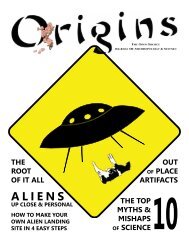Issue 10: Tech from the Military
Exploring how the military shaped the technology many of us depend on or simply desire to use on a daily basis.
Exploring how the military shaped the technology many of us depend on or simply desire to use on a daily basis.
You also want an ePaper? Increase the reach of your titles
YUMPU automatically turns print PDFs into web optimized ePapers that Google loves.
40 | ORIGINS<br />
0<strong>10</strong><strong>10</strong>1<strong>10</strong> 01<strong>10</strong><strong>10</strong>01 011<strong>10</strong>011 01<strong>10</strong><strong>10</strong><br />
011<strong>10</strong>111 011<strong>10</strong>111 00<strong>10</strong>11<strong>10</strong> 01<strong>10</strong><strong>10</strong>11<br />
01<strong>10</strong>1111 011<strong>10</strong><strong>10</strong>1 011<strong>10</strong>0<strong>10</strong> 01<strong>10</strong>1<br />
01<strong>10</strong><strong>10</strong>01 01<strong>10</strong>11<strong>10</strong> 011<strong>10</strong>011 00<strong>10</strong><br />
00<strong>10</strong>0000 011<strong>10</strong><strong>10</strong>0 01<strong>10</strong>1111 01<strong>10</strong>0<br />
01<strong>10</strong>01<strong>10</strong> 01<strong>10</strong>1111 011<strong>10</strong>0<strong>10</strong> 00<strong>10</strong>0<br />
01<strong>10</strong>0<strong>10</strong>1 00<strong>10</strong>0000 01<strong>10</strong>0001 0<br />
01<strong>10</strong>1<strong>10</strong>1 01<strong>10</strong>0<strong>10</strong>1 01<strong>10</strong>11<strong>10</strong> 01<strong>10</strong>0<br />
The very first computer to solve differential<br />
equations, called a Water Integrator, emerged<br />
in 1936 <strong>from</strong> <strong>the</strong> Soviet Union. Vladimir Lukyanov<br />
wanted to solve <strong>the</strong> problem of concrete<br />
cracking. This involved calculating <strong>the</strong> material<br />
properties of <strong>the</strong> concrete, <strong>the</strong> curing process,<br />
and possible environmental conditions. Using a<br />
series of interconnected water-filled glass tubes,<br />
level markers provided numeric answers. Adjusting<br />
<strong>the</strong> taps and plugs changed variables.<br />
The results were considered more accurate than<br />
solving <strong>the</strong> ma<strong>the</strong>matical equations by hand.<br />
The Water Integrator was used until 1980s to<br />
solve large scale modeling and o<strong>the</strong>r problems<br />
in geology, metallurgy, rocket science, and <strong>the</strong>rmal<br />
physics.<br />
Also during 1936, Konrad Zuse, a German construction<br />
engineer, invented a device to aide in<br />
lengthy calculations. His device, <strong>the</strong> binary machine<br />
named Z1, used three elements: a control,<br />
a memory, and a calculator for arithmetic. The<br />
prototype was used to develop floating-point<br />
arithmetic, high capacity memory, and yes/no<br />
command relays. In 1941, <strong>the</strong> Z3 launched <strong>from</strong><br />
www.knowyourorigins.org<br />
donated recycled materials as <strong>the</strong> first electronic,<br />
fully programmable digital computer based<br />
on a binary-point number and switching system.<br />
Old movie film was used to store <strong>the</strong> programs<br />
and data due to paper shortage. A formal presentation<br />
in 1946 was made before scientists of<br />
<strong>the</strong> Deutsche Versuchsanstalt für Luftfahrt (German<br />
Laboratory for Aviation), in Berlin.<br />
In 1946, <strong>the</strong> high level programming language<br />
Plankaikül, literally formal system for planning,<br />
evolved out of <strong>the</strong> old movie film, which included<br />
arrays, subroutines, conditional statements,<br />
iteration, floating point arithmetic, hierarchical<br />
record structures, assertions, exception handling,<br />
and records used in a style of assignment.<br />
An assignment stores <strong>the</strong> value of an expression<br />
as a variable. The Nazi government believed victory<br />
was at hand and ceased support for fur<strong>the</strong>r<br />
research. The language was not published until<br />
a paper was published in 1948 Archiv der Ma<strong>the</strong>matik.<br />
Receiving little interest <strong>from</strong> <strong>the</strong> publication,<br />
Plankalkül was not reintroduced until 1972 with


















